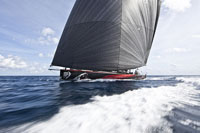
Mar Mostro Photo: Puma
The Volvo Ocean 70 is the latest and greatest ocean racer. With their carbon fiber hulls, towering rigs and canting keels, they sail faster than the wind and as a class are the fastest monohulls ever built. Based on the ongoing Volvo Ocean Race, however, the question arises, are they simply too fast and too furious to survive on the ocean? Two of the six competitors started coming apart within the first 24 hours of the race. On Monday, the Puma yacht, Mar Mostro, lost her mast over the side in winds reported to be somewhat over twenty knots. To have lost half the fleet within a fortnight on the first leg of a nine month race is worrisome. (The fleet will be reassembled, literally and figuratively, for the second leg. The two early drop outs are traveling by ship to Cape Town and Mar Mostro is limping in under a jury rig.)
A few days ago, the Puma Sailing team posted a video, Episode 2, A History of Speed, which discusses the speed potential of the Volvo Ocean 70. Ken Read, skipper of the Mar Mostro, makes several comments which seem rather prophetic. He notes, “These are not for the faint of heart. These boats are made to go, really, way too fast. And there is a lot of time spent trying to slow them down….” He goes on to say, “in 20 knots of breeze at the right angle, we are going 25 knots steady. Then you throw waves into the mix, and all of the sudden you get on big waves and you are cruising down at 25 and you can burst to 35 or even 40 knots. And 40 knots is 46 and a half miles an hours which on a sailboat is really, freaking fast. I mean, its a mistake. When you are going 40, it is a mistake. You’ve made a mistake. And you are completely out of control, I don’t mind saying it. You don’t want to go 40. You are scared sh-tless going 40. It’s a mistake.”
So are these boats just too fast? So far, in the current race, it does appear that the rigs and the hulls may be under-built for their speed. No doubt the designers and engineers will be spending considerable time back at the proverbial drawing board to ensure that the hulls and rigs of future ocean speed-demons do better.
In many respects, this is nothing new. In 1851, the American clipper ships built for the California trade, the fastest sailing ships of their times, were chronically losing spars and rigging. Captain Arthur H. Clark, in his classic book, The Clipper Ship Era, An Epitome of Famous American and British Clipper Ships, Their Owners, Builders, Commanders, and Crews 1843-1869, commented that in 1851 after rigging damage to the clipper ships Ellipse and Sea Serpent, “this was the first of a series of disasters which befell fell the clippers that year, and which proved pretty clearly that their power of carrying canvas had been underestimated. It became quite evident that these ships could stand stouter spars and rigging …”
No doubt the sailors, designers and engineers will figure out how to make the Volvo Open 70s hold together, just as the clipper ship captains and designers managed to minimize rigging damage in the 1850s.
[iframe: width=”560″ height=”315″ src=”http://www.youtube.com/embed/6Nh-iDHJW-o” frameborder=”0″ allowfullscreen]
